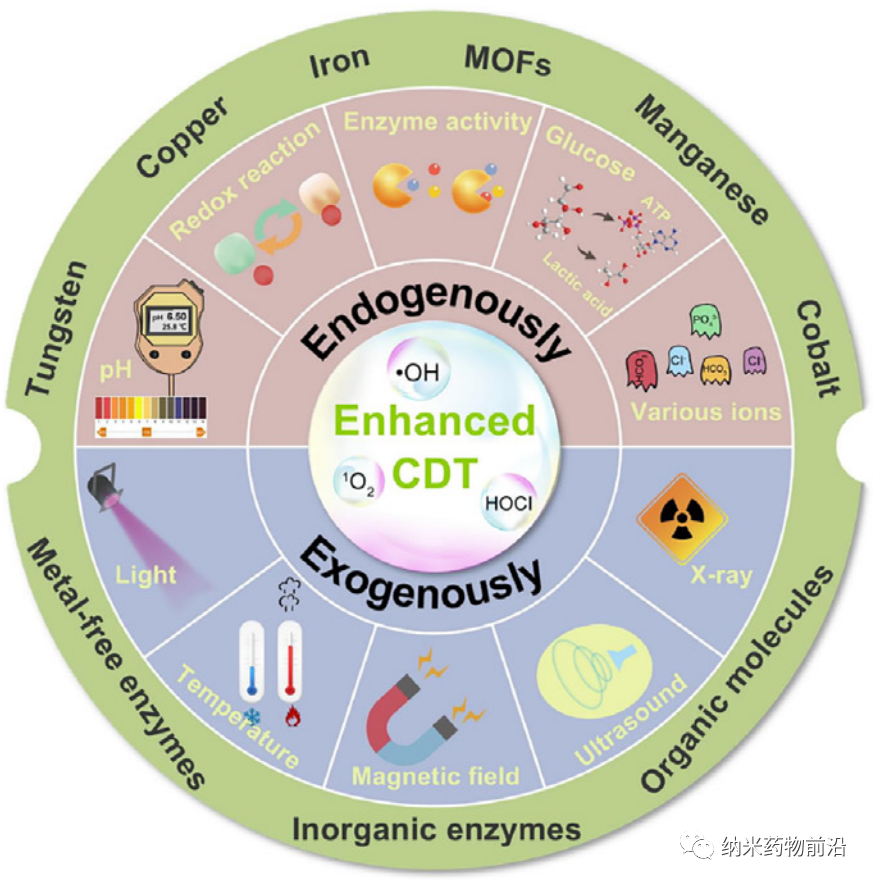Yang Piaoping/Li Chunxia/Lin Jun Coord. Chem. Rev. Long review: The latest advances in the use of nanoplatforms triggered by endogenous and exogenous stimuli to enhance chemokinetic therapy
Professor Yang Piaoping of Harbin Engineering University, Professor Li Chunxia of Shandong University, and researcher Lin Jun from the Changchun Institute of Applied Chemistry of the Chinese Academy of Sciences jointly published a long review of "Coord. The latest developments in treatment.

In view of some unique internalization characteristics of tumor microenvironment (TME) (mainly including hypoxia, acidity, higher concentration of H2O2 and glutathione (GSH), etc.), advanced nanotechnology has been introduced to improve intracellular Reactive oxygen species (ROS) levels are mainly related to the Fenton and Fenton-like reactions of transition metals, metal-catalyzed reactions and peroxidase-catalyzed reactions, which are used for tumor chemokinetic therapy (CDT). However, there are many unavoidable problems, such as harsh Fenton reaction conditions of iron-based materials, low reaction efficiency, limited endogenous H2O2, ROS generated by the neutralization of the antioxidant system, and the unsatisfactory therapeutic effect of a single CDT mode. This limits the application of CDT in the field of anti-cancer, which in turn promotes the generation and development of enhanced CDT nano-platforms with better therapeutic effects. Recently, Professor Yang Piaoping of Harbin Engineering University, Professor Li Chunxia of Shandong University, and Researcher Lin Jun of Changchun Institute of Applied Chemistry, Chinese Academy of Sciences reviewed the enhanced CDT anti-tumor strategy, which was published in the internationally renowned chemical journal Coordination Chemistry Reviews (IF: 22.3). "Recent advances on endogenous/exogenous stimuli-triggered nanoplatforms for enhanced chemodynamic therapy" long review article (up to 70 pages), aimed at systematic discussion, classification and in-depth review of enhanced CDT anti-tumor strategies that have emerged in recent years , In summary, involving the amplification strategy of oxidative stress triggered by endogenous/exogenous stimuli. Endogenous stimuli mainly come from TME or cancer cells (such as acidic pH, glucose, GSH, some specific enzymes, etc.), and exogenous stimuli include light, heat and ultrasound. Here, according to the source of these stimuli, the enhanced CDT nanomaterials are divided into three categories, namely, endogenous stimulus-responsive nanomaterials, exogenous stimulus-responsive nanomaterials, and endogenous/exogenous costimulatory-responsive nanomaterials. . The author analyzes and discusses representative examples from the rational design and preparation of materials, mechanism of action, and potential medical applications. Finally, it summarizes the difficulties and bottlenecks encountered in the current development of CDT, and points out the preliminary direction of the future development of this field, in an effort to mobilize and coordinate the potential forces of biology and chemistry.

The main content of this article includes:
The first part (introduction) introduces the types, sources and biological functions of ROS, the generation and therapeutic advantages of ROS-mediated CDT, and the purpose of writing this review.
The second part (traditional Fenton reaction-based CDT) mainly introduces the Fenton reaction-based strategy to enhance intracellular oxidative stress, several major problems that limit its further development, and corresponding solutions.
The third part (internal microenvironmental stimulation) introduces the use of the unique characteristics of TME (such as pH, redox environment, highly expressed enzymes, glycolysis process, ions, etc.) to initiate various strategies for high-efficiency CDT, including single endogenous Stimulus response strategy, two or more endogenous stimulus response strategies.
The fourth part (stimulation of external energy field) mainly discusses the application of external stimulus (such as light, heat, ultrasound and X-ray) responsive nano-platform in the field of enhancing CDT anti-cancer field.
The fifth part (endogenous/exogenous costimulation responsive CDT nanoplatform) introduces the internal regulation of TME or the multiple stimulus responsive CDT nanoplatform in response to TME and external stimuli, including glycolysis/heat, redox reaction/ Heat, enzyme/heat, pH/heat, pH/heat/redox reaction and other multi-responsive nanosystems.
The sixth part (other responsiveness) introduces three other nano-platforms that enhance CDT responsively, including blocking autophagy of tumor cells, using endogenous H2S to stimulate the establishment of an efficient Fe3+/Fe2+ conversion system, and enhancing CDT Bacterial bioreactor.
The seventh part (conclusions and prospects) mainly summarizes this article, points out several key issues currently facing the enhanced CDT nano-platform, and puts forward some corresponding suggestions and opinions on future research work, with a view to realizing the next CDT as soon as possible. Rapid development step by step.
The first author of this article is Sun Qianqian, a doctoral student from Harbin Engineering University, and the corresponding authors are Professor Yang Piaoping of Harbin Engineering University, Professor Li Chunxia of Shandong University, and Researcher Lin Jun of the Changchun Institute of Applied Chemistry, Chinese Academy of Sciences. This article was supported by the National Natural Science Foundation of China, the Natural Science Foundation of Heilongjiang Province, the Natural Science Foundation of Shandong Province, the Postdoctoral Science Foundation of China, and the Fundamental Research Fund of Central Universities.
Literature link:https://www.sciencedirect.com/science/article/pii/S0010854521005415?via%3Dihub
This information is sourced from the Internet for academic exchanges only. If there is any infringement, please contact us to delete it immediately.
18915694570
Previous: AEM: Acid-free and alk


